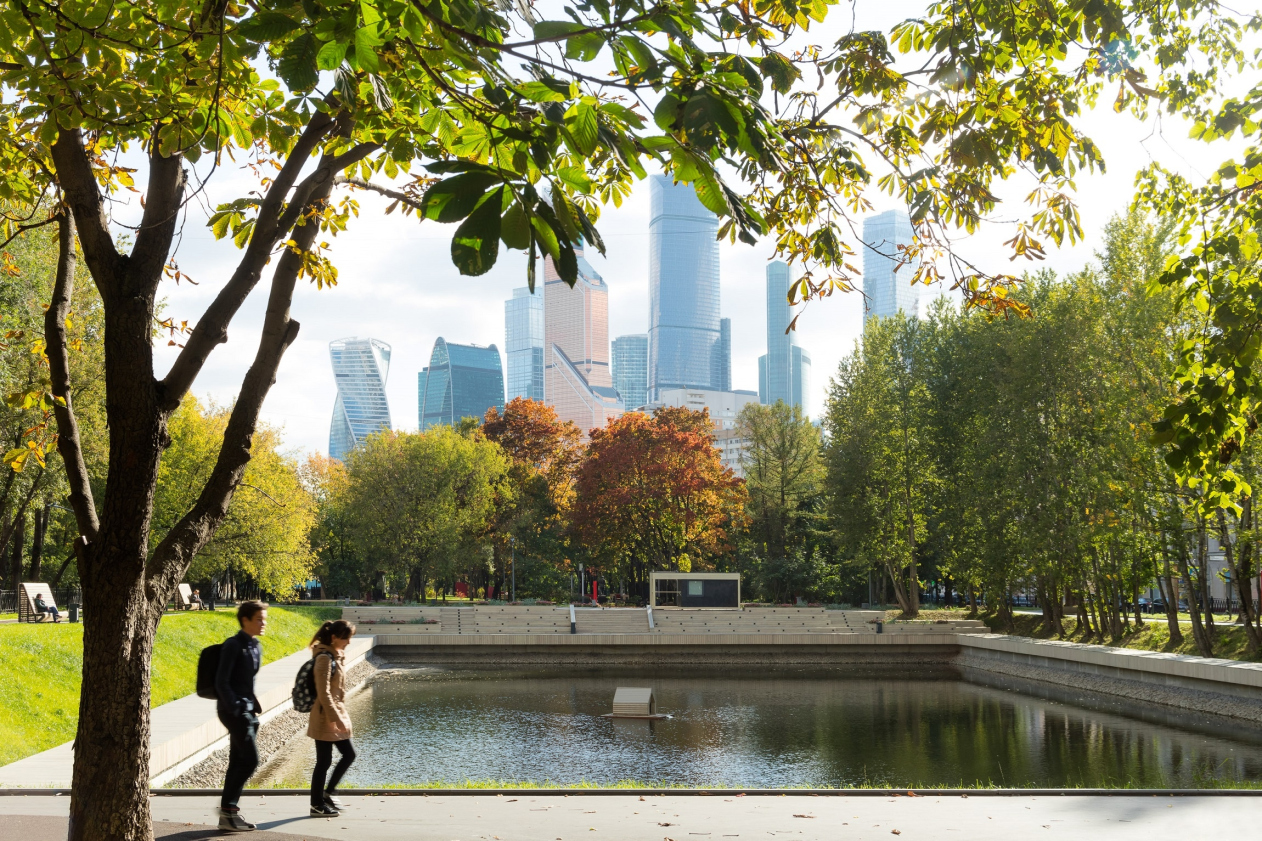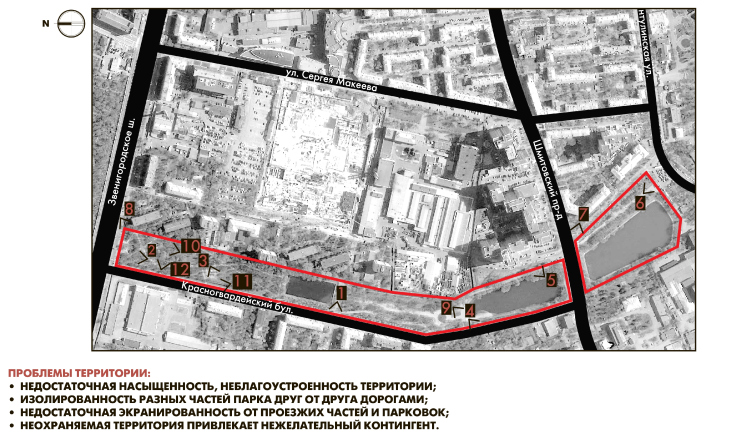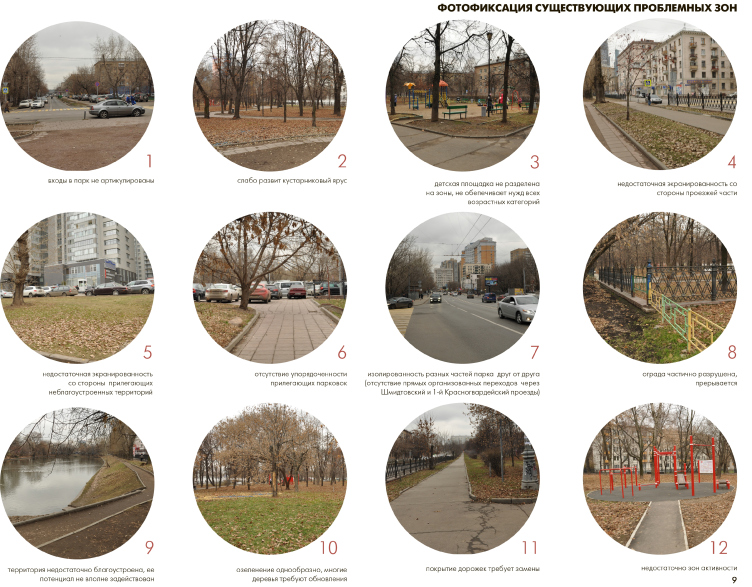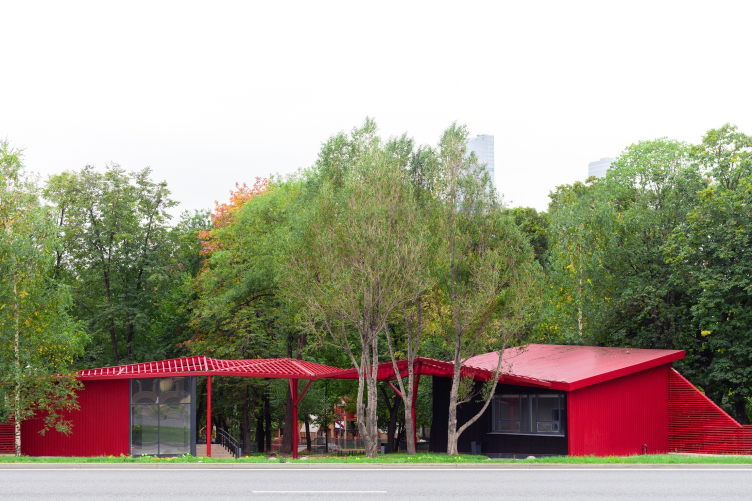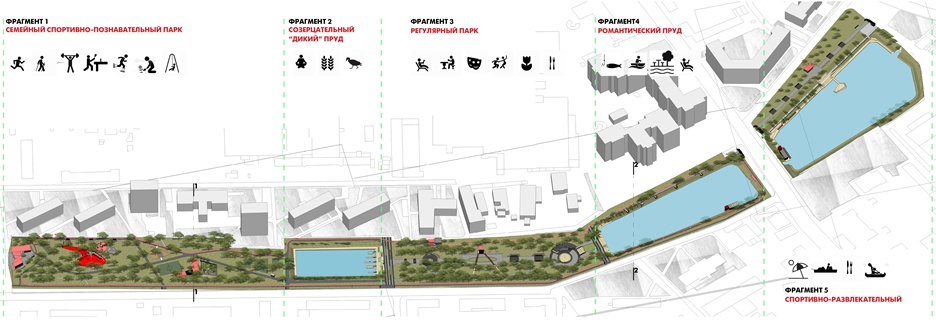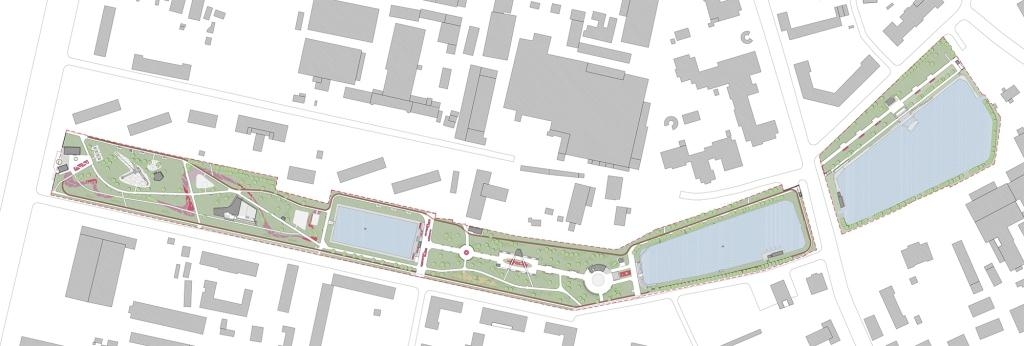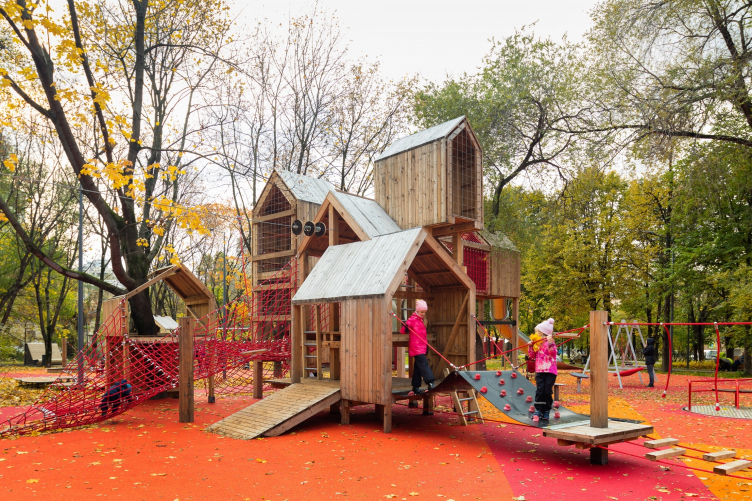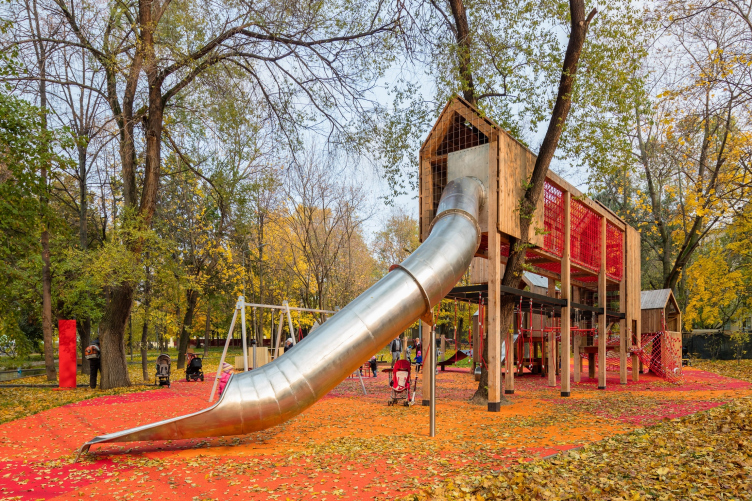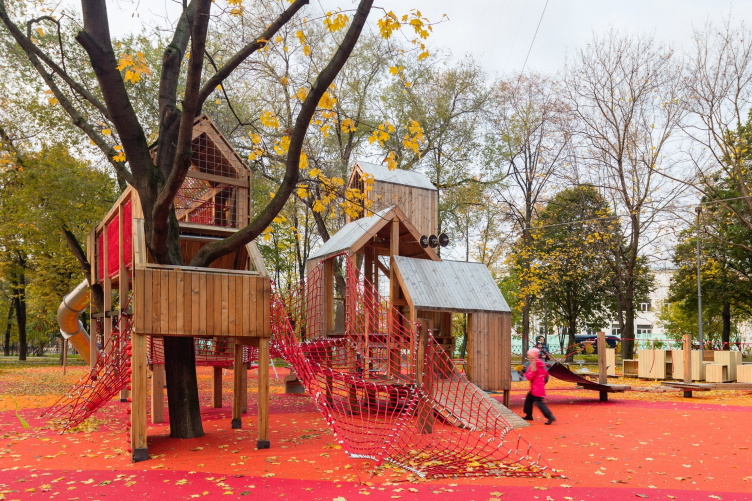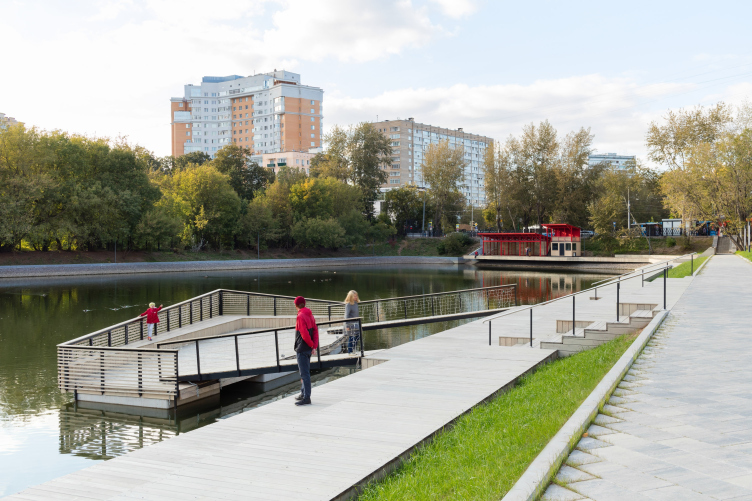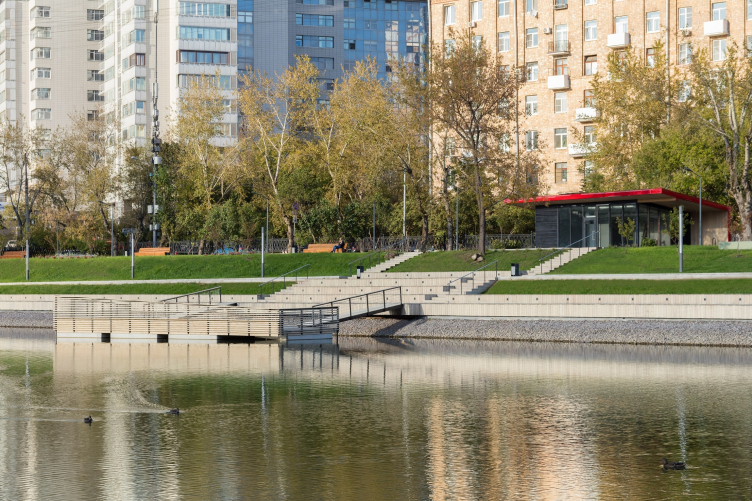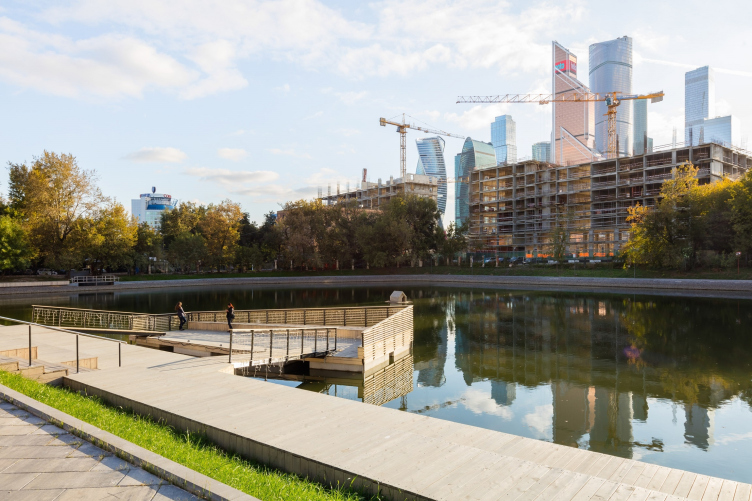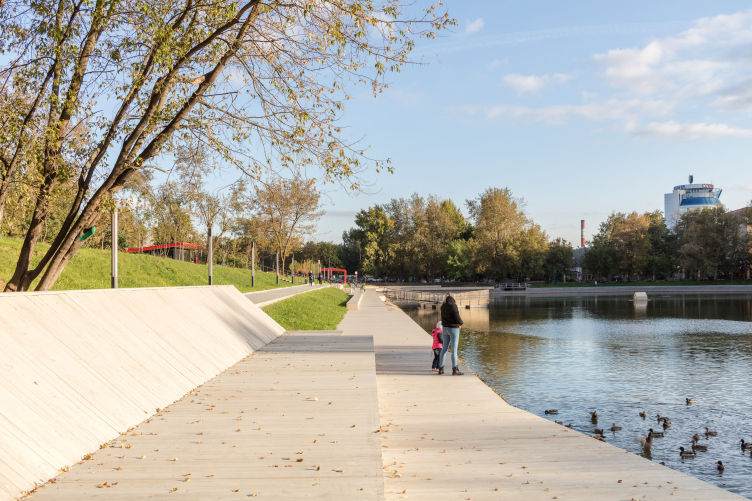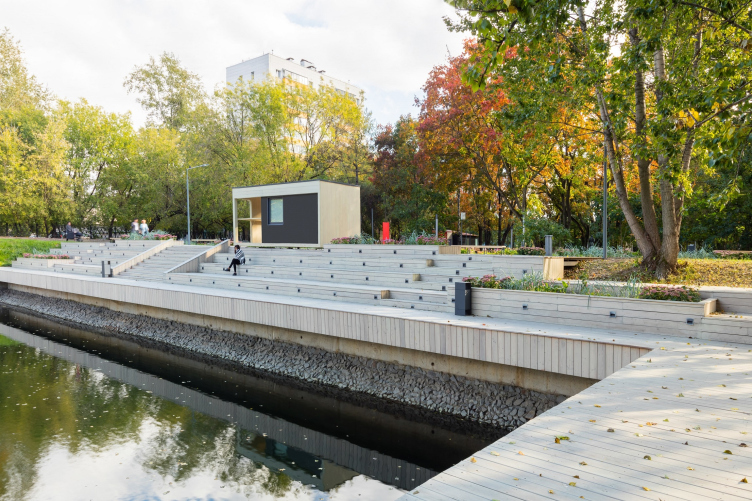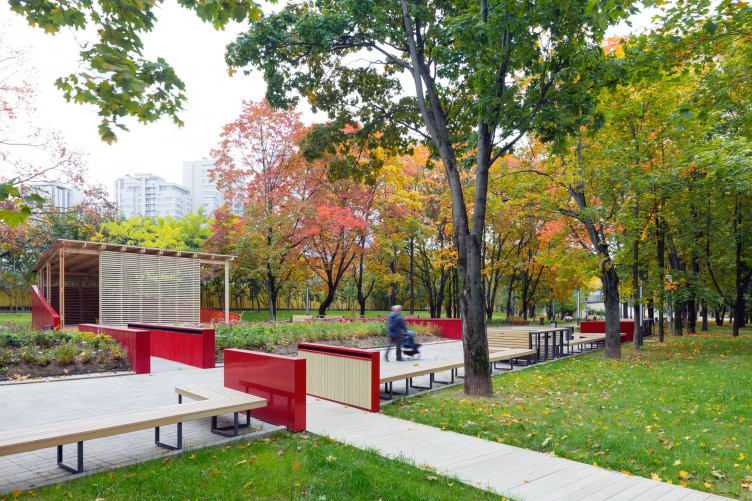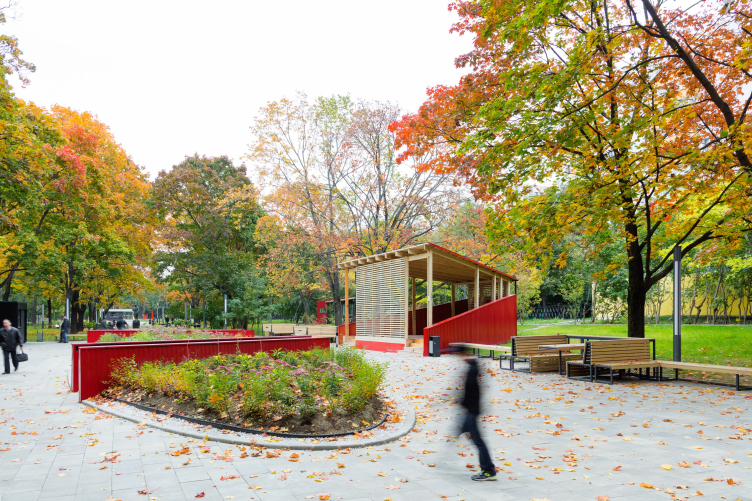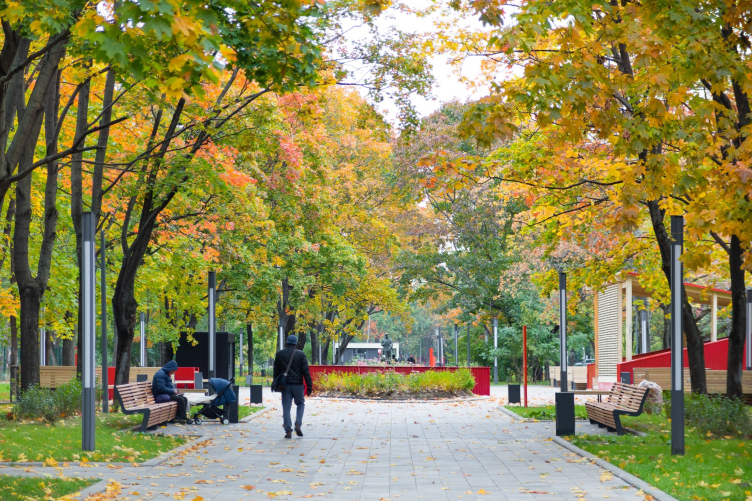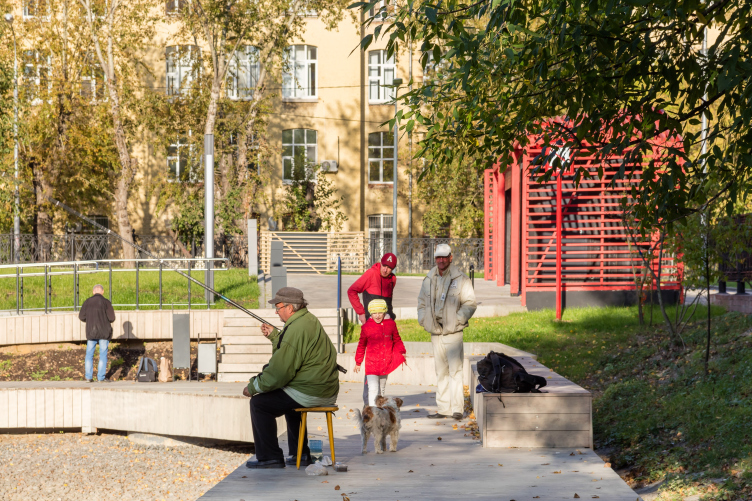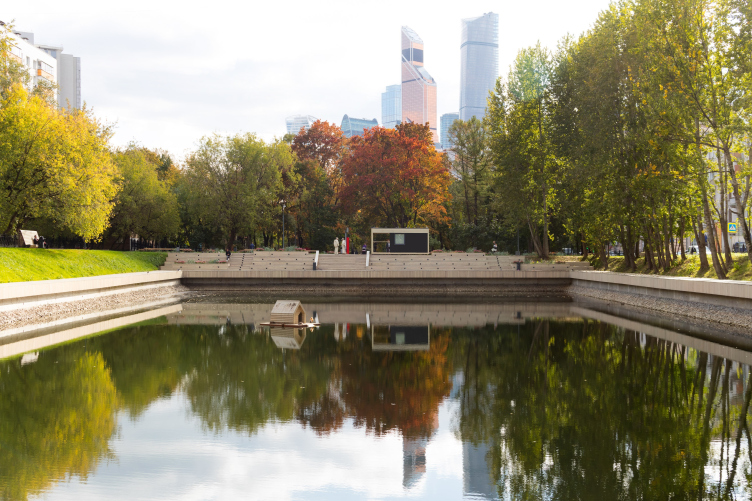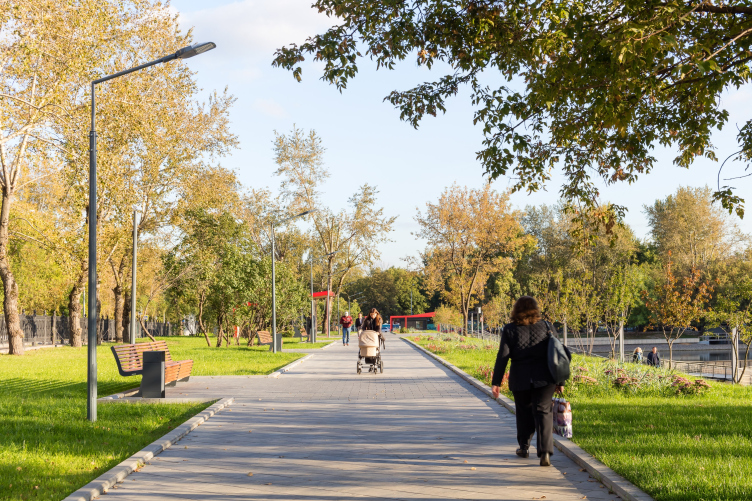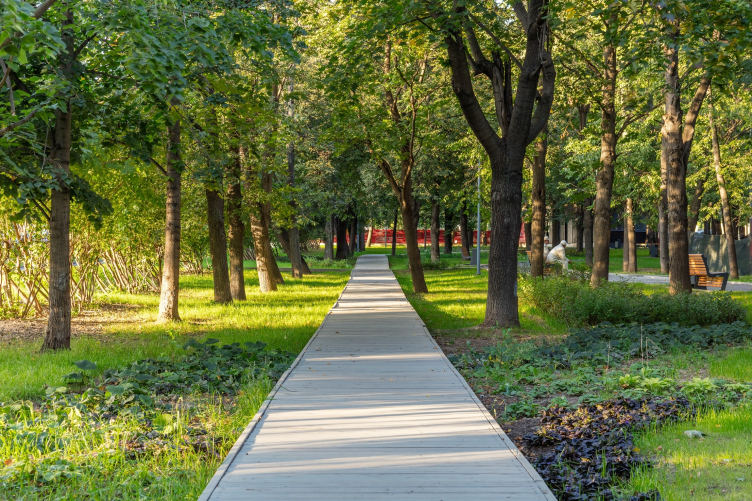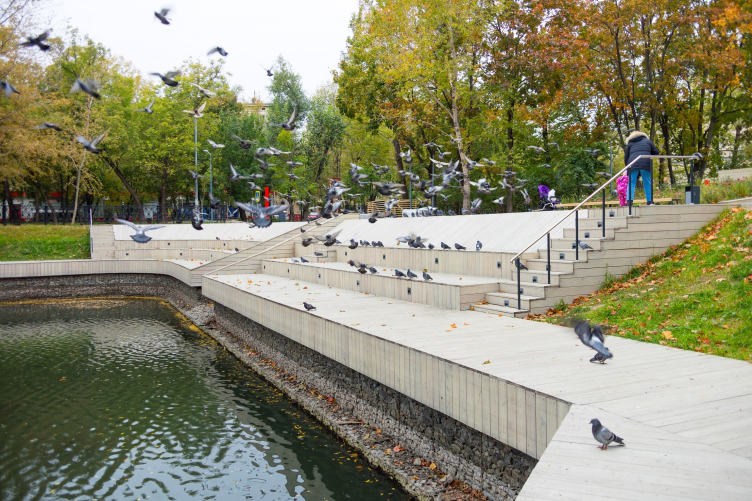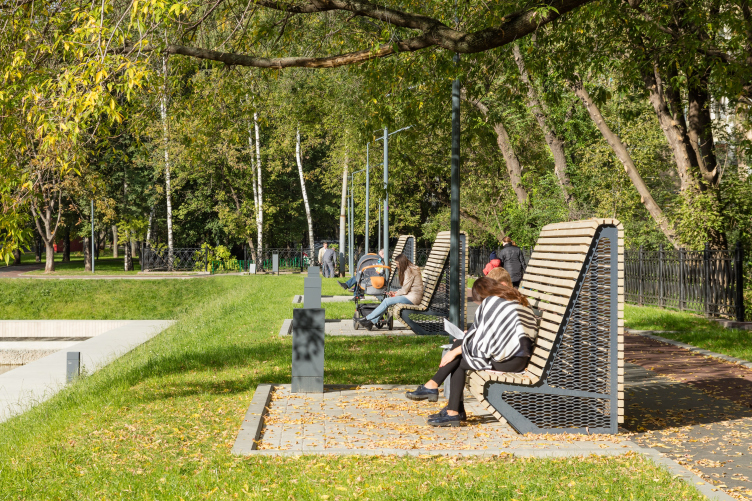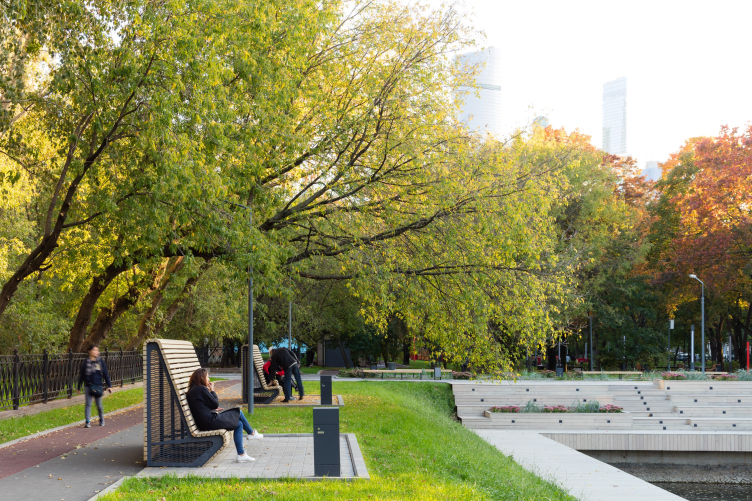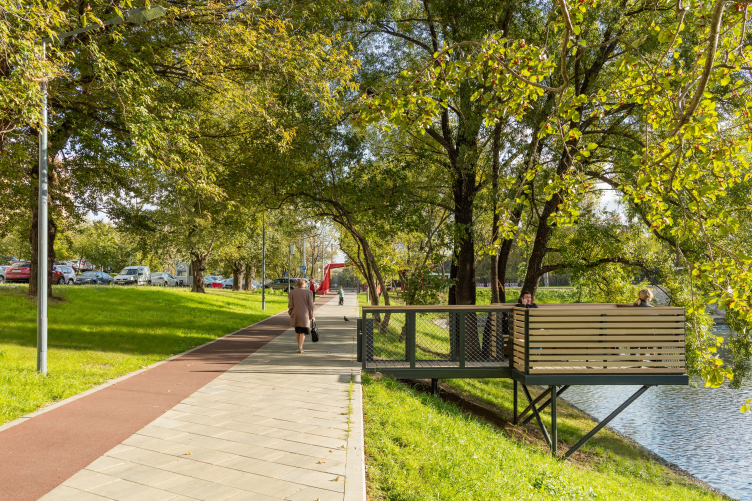The story of reorganizing the “Kransogvardeiskie Prudy” park is typical for the practice of Wowhaus, which has been into improving city spaces and recreational areas for about ten years now. There is meticulous work and there is deadline pressure, there is struggling with the harsh realities of the Russian construction industry and overcoming the challenges of the climatic cataclysms. However, this work also leaves plenty of room for creativity, which makes it all worth it.
Three Ponds of Memories
Located west of the Moscow City business center, this cluster of a few green areas is definitely not on the top of Moscow parks list. Nevertheless, the new trends have finally reached this place as well: the park “Krasnaya Presnya”, which the city inherited from the Studenets-Gagarins estate, has already been reformed and landscaped. Historically, the “Krasnogvardeiskie Prudy” park is one of its parts, even though today it looks more like a green boulevard – as a matter of fact, the street running along the western border of the park is called “Krasnogvardeiskiy Boulevard”.
The three ponds that once gave the name to the park, were dug out in the early XVIII century. The biggest one (called “Nizhny”, meaning “the lower”) is squeezed between the 1st Krasnogvardeiskiy and the Shmitovsky drives. The two other ponds are located to the north of this one – their green zone, averaging 70 meters, stops at the Zvenigorod Highway. During the soviet time, the ponds were clad in concrete casing, which was rather convenient for the ducks and the anglers. The park was intended for the local use: it had neither amusement rides nor heritage sites in it that would draw crowds from the outside. One could compare it to a slightly hyperbolic yard that was spilling over its boundaries – it was a haunt of moms going for walks with go carts and toddlers, pensioners from the surrounding houses, and the local youngsters who would periodically raise a racket here.
Vox Populi
In 2015, the Department of Culture and the management of “Krasnaya Presnya” decided to include the “Kransogvardeiskie Ponds” into the sphere of influence of the new park policy and invited for developing the project Wowhaus architects, known for their ability to not only uncover the potential of various venues but also involve the future users to the creation of the program, using the methodology of social and cultural programming.
Reorganization of the Krasnogvardeiskie Ponds. View of the Moscow City through the Upper Pond © WOWHAUS
Reorganization of the Krasnogvardeiskie Ponds. Analysis of the original situation © WOWHAUS
Reorganization of the Krasnogvardeiskie Ponds. Analysis of the problem spots © WOWHAUS
To collect and analyze the design information, the architects invited their steady partners in that field – KB23. The sociological survey proved the desire of the local residents to keep the intimate character of the park. “The poll data made us us reconsider some of our preliminary solutions – shares the chief architect of Wowhaus, Daria Ionova (Melnik), who curated the project of reconstructing the “Krasnogvardeiskie Ponds” – Parents and their little kids, and the senior citizens that usually go for walks here, were not so much in need of some spectacular amusement rides or other noisy activities as children’s playgrounds, sports fields, and places for quiet rest and recreation”.
The Red Entrance
Reorganization of the Krasnogvardeiskie Ponds © WOWHAUS
As far as the starting point was concerned, the architects used the main entrance from the side of the Zvenigorod Highway: at this point, the width of the park reaches its minimum – about 62 meters, so, from the side of the highway this place looked just like a rather unkempt piece of parkland.
It was also necessary to accentuate the entrance, and the architects of Wowhaus flanked it with two black-and-red pavilions connected by an openwork pergola that encompasses a cluster of preserved trees. The resulting structure is strikingly different from the stylized decorative portals that have recently adorned the entrances to the numerous Moscow parks – these pavilions are not meant to imitate some sort of holiday, their function being much more honest and utilitarian: one can have here a cup of coffee, rent a scooter or buy a book to read in the park. They signify an entrance to a territory that was designed and built for people.
Reorganization of the Krasnogvardeiskie Ponds © WOWHAUS
Reorganization of the Krasnogvardeiskie Ponds © WOWHAUS
Five Parks Instead of Just One
The information about the life of the park, specifically, its terrain, ponds, and greenery, as well as the surrounding buildings, prompted an unconventional solution: the authors decided to refrain from the idea of working with this territory “from beginning to end” and fractured it into several fragments with different functions and different approaches to infrastructure and landscape design.
Reorganization of the Krasnogvardeiskie Ponds. Plan of the functional and stylistic organization of the territory © WOWHAUS
Reorganization of the Krasnogvardeiskie Ponds. Masterplan © WOWHAUS
Children’s Paradise
The zone situated immediately behind the entrance is occupied by sports fields and family recreation venues; the architects preserved the natural character of the park as much as possible here. The gem of this zone is the already-famous “playground in the trees”, something like a cross between a fairy tale castle and a rope park. A few differently sized little houses connected by boardwalks and ladders are mounted on tree trunks and special columns. The project got into the spotlight of all the architectural and city media long before it was implemented, which comes as no surprise – this sci-fi playground was created with the input from the architects who had previously designed the children’s club “Koni na Balkone” (“Horses on the Balcony”), and these architects used their own experience in involving children in the creative process of designing the exciting game environment. There are no preset scenarios here, the children themselves deciding what games to play, and how. Some families specifically come from far away specially for this playground.
Reorganization of the Krasnogvardeiskie Ponds © WOWHAUS
Reorganization of the Krasnogvardeiskie Ponds © WOWHAUS
Reorganization of the Krasnogvardeiskie Ponds © WOWHAUS
Reorganization of the Krasnogvardeiskie Ponds © WOWHAUS
The next zone is the territory around the Upper Pond, also treated in the natural key, with a boardwalk. The third fragment – located between the Upper and the Middle ponds – is designed as a regular park with a central promenade, flowerbeds, a few pavilions, an amphitheater around the dance floor, and also a small square, the center of which, according to the architects’ proposal, is the local curiosity – the “October Days” monument.
Reorganization of the Krasnogvardeiskie Ponds. The central promenade © WOWHAUS
The next zone, which spreads around the second pond, is designed in a romantic spirit: a few gazebos with benches, and a boat renting point.
...and Circuses
The last fifth fragment with the “Lower Pond”, separated from the mainland by the Shmitovsky Driveway and having no nearby houses, became the center of the noisy pastime, which, as the sociological survey showed, the other zones rejected. There is a floating stage in the middle of the huge pond, and its banks have been turned into an amphitheater for 150 spectators and a large flooring sun bed. On the City Day 2017, there was an orchestra playing on that stage; in the upcoming season, the program is promising to be more diverse.
In order to ensure a better connection between the two major parts of the park, the architects planned to remove the pedestrian stoplight on the Shmitovsky Drive but, regretfully, this plan was not to come to pass.
Reorganization of the Krasnogvardeiskie Ponds. The floating stage © WOWHAUS
Reorganization of the Krasnogvardeiskie Ponds. The floating stage © WOWHAUS
Reorganization of the Krasnogvardeiskie Ponds © WOWHAUS
Reorganization of the Krasnogvardeiskie Ponds © WOWHAUS
Reorganization of the Krasnogvardeiskie Ponds © WOWHAUS
The Connecting Red Line
The entire length of the park is pierced by a “secret trail” – a pedestrian route with sightseeing platforms and “surprise” objects that the visitors run into as if by accident.
In addition, the authors of the project decided not to argue with history and converted the name of the park into an obvious color code. For “Krasnogvardeiskie Prudy” (“Red Guard Ponds”) that are part of the “Krasnaya Presnya” (“Red Presnya”) park, they proposed to use the red color. It is complemented by gray and beige-ochre color of wood.
Reorganization of the Krasnogvardeiskie Ponds © WOWHAUS
Red Greenery and Other Curious Dendrology
In addition to the objects and guiding arrow signs, the red color is also present in vegetation here: the dendrologists have put together a collection of plants with red leaves or branches – or at least the kind that turns red in autumn.
Reorganization of the Krasnogvardeiskie Ponds © WOWHAUS
The reconstruction of the park required a major revision of its greenery. There were a lot of trees in the park but not all of them were healthy; over the long years of “wild” growth, many cultured trees and shrubs died, junk underwood grew up, and the flowerbeds practically disappeared. Because of the strong winds of the winters of 2016-2017, many trees fell down – in a word, there arose a necessity for planting new trees: these include the now-popular kinds of trees, shrubs and perennials that grow well in the city.
Reorganization of the Krasnogvardeiskie Ponds. Pavilions next to the Lower Pond © WOWHAUS
Reorganization of the Krasnogvardeiskie Ponds © WOWHAUS
Reorganization of the Krasnogvardeiskie Ponds © WOWHAUS
Reorganization of the Krasnogvardeiskie Ponds © WOWHAUS
Reorganization of the Krasnogvardeiskie Ponds © WOWHAUS
Reorganization of the Krasnogvardeiskie Ponds © WOWHAUS
Reorganization of the Krasnogvardeiskie Ponds © WOWHAUS
Reorganization of the Krasnogvardeiskie Ponds © WOWHAUS
The flowerbeds were individually developed for each of the segments of the park, with regard to its function and style – regular or, conversely, landscaping kind. At some places, the architects would choose to use simple forest plants, at some places – more flashy-looking but still fuss-free garden flowers and herbs. The boundaries of the zones are highlighted – and at the same time smoothed out – with a mix of herbs.
Realization: Express and Improvised
The project was finished in the middle of 2016 but the construction work in the park did not begin until October. The management of the park was to organize a tender to choose the contractor, and, as it often happens, the process took quite a long time – until the advent of the unexpectedly early winter. Practically the whole work was suspended until the next year. The only thing that could be done was preparing the foundations for the pavilions, but then again, some changes were introduced because a different technology was used.
As a result, from April to October 2017, the construction was done by express and improvisation method; some of the solutions had to be simplified in order to meet the construction schedule.
Before the start of the landscaping work, the park launched the process of reconstructing and clearing the ponds that included reinforcing their banks with gabions. Due to the fact that the ponds are in the books of Mosvodostok (the Moscow water disposal service), and not the park itself, their reconstruction was handled by another contractor – the result of his efforts was strikingly different from the solutions proposed in the project, and the architects had to make revisions to the structure of the boardwalks and amphitheaters to put things in order.
Just Add Water
The not-so-long list of project losses has one position in it that stands out with its objectively insurmountable character, though temporary, as the authors of the project hope. The ponds did survive the years of dilapidation, with losses in terms of purity but still with water. After the reconstruction, the ponds grew shallow – which was the reason the architects had to abandon the idea of a boat renting point on the Middle Pond, and the twin-hull boat renting point at the Lower Pond had to be turned into a changing room for the sunbed. But then again, the architects hope that this situation is only temporary and the ponds will get filled with water soon.
Reorganization of the Krasnogvardeiskie Ponds © WOWHAUS
Luckily, almost all the other solutions got realized to a letter, just as the architects were able to achieve the integrity of the landscape and architectural inclusions, so characteristic of Wowhaus projects. Some of the solutions even turned out to be more effective and efficient than the authors anticipated.
Bench Reversal
In the conditions of time and budget constraints, the architects had to combine new minor forms with author creations. One of the most popular ones is the “high back bench”.
Reorganization of the Krasnogvardeiskie Ponds © WOWHAUS
The beauty of descriptive names is in their self-explanatory vividness. The size of the back of the bench is outstanding indeed but what is more important is the fact that it is the key to solving the longstanding problem of all parks: the necessity to choose between the comfort of sitting and the opportunity to admire the surrounding scenery. Usually, benches are placed along the trails, facing the promenade – and the person who sits down on them automatically finds himself with his back to all the beauty of the park, through which the trail runs. The solution that Wowhaus proposed is revolutionary in its radical simplicity: they turned the bench with its back to the passageway, and, in order to make sure that the person who is sitting on it does not get a creepy feeling because of what is going on behind his back, covered the rear with a high back. The idea went straight home. Once they were installed, these benches became an instant hit with lovebirds and introverts.
Reorganization of the Krasnogvardeiskie Ponds © WOWHAUS
A Park Study
Yet another successful solution is the format of the “bank pavilions”. Because of the steep banks of the middle pond, you could not place regular benches alongside it, while building an amphitheater here would be prohibitively expensive. A compromise was found in small “balcony” or “veranda” gazebos, which were placed above the water and connected to the bridge by a boardwalk. Such boxes can comfortably host a company of four to six people. Being formally detached from the outside world will let one feel more comfortable but, being of the open-air type, the verandas are vandal-proof.
Reorganization of the Krasnogvardeiskie Ponds © WOWHAUS
And, while a couple of years back Wowhaus came up with an urban open-air “living room”, now the list of innovations proposed by this company has been augmented with an urban “open-air” study.

